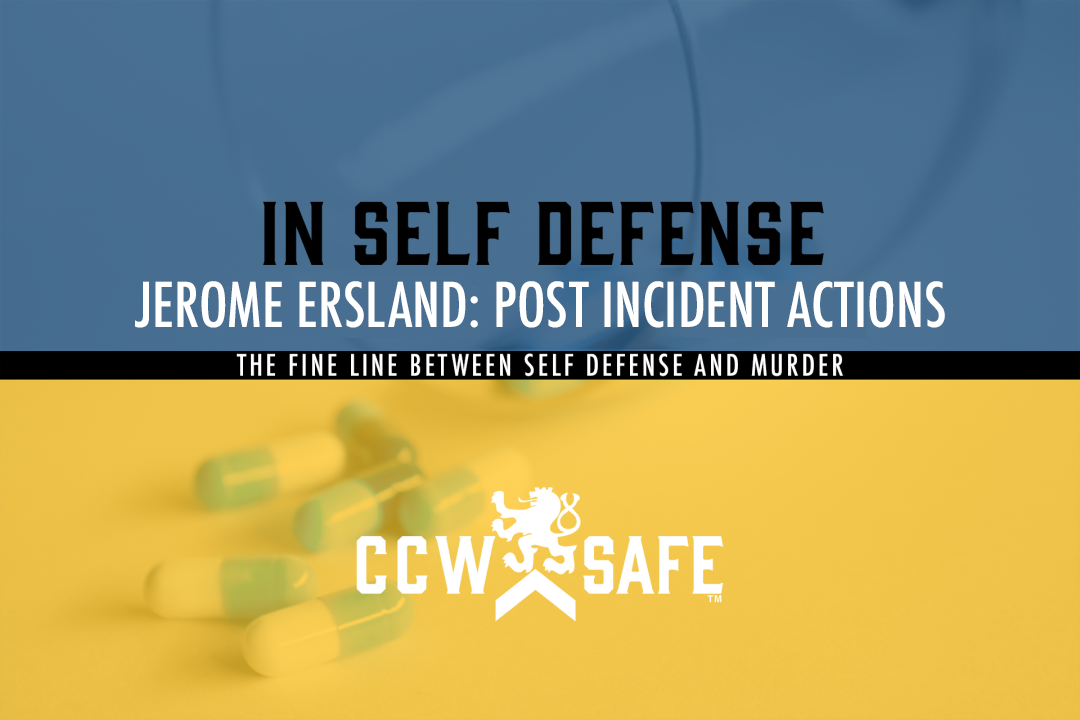
Posted on March 15, 2019
“In Self Defense” The Jerome Ersland Case: The Line Between Self Defense And Murder- Post-incident Actions
The Jerome Ersland Case
The line between self-defense and murder
Part 5: Post-incident Actions
In this installment of “The Four Elements of Self-Defense,” we explore how Jerome Ersland’s post-incident actions factored into his legal defense. Like most of the shooters we analyze, Jerome Ersland was NOT a CCW Safe member. We’ve chosen his case because it provides clear lessons for concealed carriers regarding what can go wrong in a self-defense shooting.
At first, people praised Jerome Ersland as a hero for defending himself and his co-workers when masked men entered the Reliable Discount Pharmacy in Oklahoma City and tried to rob the business at gunpoint. Ersland, a career pharmacist, had been robbed before, and he knew pharmacies we sought after by criminals for the valuable narcotics kept behind the counter. For that reason, he kept a firearm at work — two actually a Taurus Judge and a Kel-Tec .380.
According to Ersland’s statements to police, and interviews that he gave to the press, two masked robbers entered the pharmacy, each carrying cheap foreign-made .38’s. One of them shouted, “You’re gonna die,” he said. He recounts grabbing both of his firearms, one in each hand, and returning fire. Ersland claimed to be grazed by a bullet during the shootout. One of the assailants was struck in the head and the chest and died in a pool of his own blood. The other robber fled.
“I feel that [people have] a right to defend themselves at their home or at work.” Ersland said in an interview in the The Oklahoman just three days after the shooting. “People deserve to be safe and not be afraid of people [who] want to take money when they don’t work for it.”
Oklahoman’s agreed, and Ersland’s actions were widely celebrated. That’s why District Attorney David Prater’s decision to charge Ersland with first-degree murder drew public outrage. But Prater knew a number of things that the public wouldn’t learn until trial.
CCW Safe’s Critical Response Coordinator Gary Eastridge worked for the Oklahoma City district attorney at the time of the Ersland shooting. He said it was the day after the shooting that the technician who recovered the surveillance video signaled there was a problem. The problem was that the video didn’t match Ersland’s testimony.
Here’s what the video shows:
Two teens, Antwun Parker and Jevontai Ingram enter the pharmacy and dawn ski masks. As Parker struggles to get the eyeholes properly lined up, Ingram produces a weapon, not a cheap .38, but a semi-automatic pistol. Parker is unarmed. Ersland, who is out of frame, retrieves just one gun, his Taurus Judge which is armed with .410 buckshot and .45 rounds. He fires, and a pellet strikes Parker in the temple. Parker immediately falls to the ground.
Ingram flees, and Ersland follows him out of the pharmacy. Although it’s not captured on the surveillance video, investigators learned that Ersland fired two or three rounds at Ingram as he retreated. None of his shots found their mark.
Then Ersling re-enters the pharmacy and steps over Parker where he lay below the camera’s view. Then he turns his back on Parker and walks off frame to the back of the store where he retrieves his Kel-Tec .380. He re-emerges, walks up to Parker’s incapacitated body and fires five rounds to center mass.
“There were the versions told to law enforcement,” Gary Eastridge says, “and because there was such intense media coverage of the case, Mr. Ersland made the decision to make public statements. He made many, and there were several inconsistencies between those statements and between those statements and the evidence.”
Don West, veteran criminal defense attorney and National Trial Counsel for CCW Safe says, “One of the quickest ways to sour a good working relationship with the investigator or the DA is to lie and get caught.” In the Ersland case the lies kept on coming.
In a bizarre recorded interview Ersland gave to investigators, he claims that he had killed lots of people during his service in the 1991 Gulf War. He claims a combat injury had blasted his vertabra. He wears a back brace, he claims, because of recent surgery. Detectives, however, found that Ersland’s combat claims were baseless. The local newspaper researched his military record and found Ersland spent the Gulf War serving as the pharmacy chief at Altus Air Force Base — in Oklahoma. Moreover, investigators found no records of any back surgeries.
Even the alleged bullet graze wound turned out to be a fabrication. “This played against him,” Eastridge says, “that he made an attempt to create evidence to support his claim.”
The easy lesson for the concealed carrier is to never lie to investigators after a self-defense shooting. The perennial lesson we learn from practically all the cases we explore is that you should not give detailed statements to law enforcement without the advice of an attorney. Ersland had done plenty wrong before he made the first statement about the shooting of Antwun Parker, but the conflicting accounts and flat out lies he told to investigators and to reporters helped guarantee his ultimate conviction.
In our series “The Four Elements of Self-Defense,” we explore how location, escalation, reasonable fear, and post-incident actions can affect the legal defense in self-defense shooting. In the next installment, we’ll look at the verdict in Jerome Ersland’s case and recap the lessons learned for concealed carriers.
 |
SHAWN VINCENT- LITIGATION CONSULTANTShawn Vincent is a litigation consultant who helps select juries in self-defense cases, and he manages public interest of high-profile legal matters. If you have any questions for Shawn, or would like more articles like this, let us know belo |